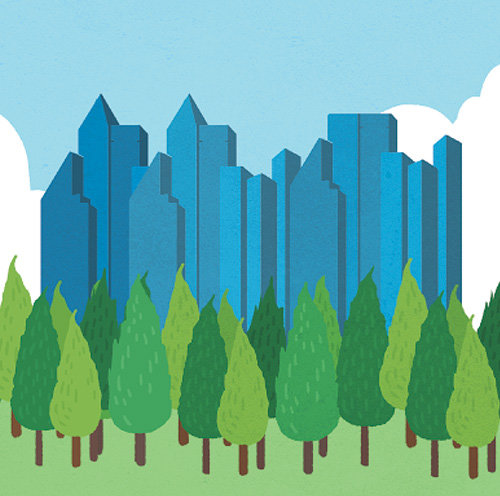Data give fresh air to cities
Data give fresh air to cities
Posted July. 04, 2020 07:40,
Updated July. 04, 2020 07:40


Considerable effort is being put into enhancing air quality even though the COVID-19 pandemic has distracted public attention from the chronic issue of fine dust. One of the most important projects that require constant effort is to build urban forests.
Many municipal governments across South Korea have released their development plan to expand green areas in cities with relevant bills waiting to pass the National Assembly. It is welcome news that cities can get greener thanks to larger forest areas. Urban forests not only help reduce fine dust particles but also keep average temperatures lower by three to seven degrees Celsius than normal levels, which offsets the heat island effect. Added to this, they can ensure noise reduction and air purification. The fact that 90 percent of the Korean population live in forest-deficient urban areas only makes it all the more necessary to develop a larger area of city forests. The Seoul capital area, home to half the national population, falls way behind the global standards of per-capita urban forest coverage considering that the World Health Organization's recommended per capita urban forest area is 9 square meters. Seoul, Gyeonggi Province and Incheon have the per-capita urban forest area of 4.38 square meters, 7.69 square meters and 8.23 square meters, respectively. Seodaemun District in Seoul ranks lowest among South Korean municipalities with only 0.86 square meters of urban forests. Given other major cities across the globe such as New York (23 square meters), London (27 square meters) and Paris (13 square meters), there is a high need of green forest areas in South Korean cities.
Nevertheless, we should consider that building large forests in cities is associated with the issue of high land costs and limited physical space. This is where strategic access comes in – based on many years of weather and air quality data.
Stuttgart, one of the major German industrial cities, shows a great example of how to deal with urban forest development and management using data-driven methodologies. It boasts off a 100-hectare urban forest zone that stretches eight kilometers, which facilitates urban air ventilation and circulation to help reduce levels of fine dust particles by more than 30 percent. Experts advise that other cities devise multi-faceted blueprints to utilize data with weather conditions, topographies, wind circulation and ecological aspects taken into consideration. The 4th Industrial Revolution, thankfully, has enabled cities to access real-time data that they need to handle to grow plants and trees such as temperatures, humidity levels and air quality conditions. Such helpful data sets can make it easier for cities to expand and manage urban forests.
Cities can increase the effectiveness and efficiency of urban forests, which they may have worked hard to build, by applying data to their projects to provide the best environment for plant growth. Once related data are collected to build and manage forests in cities, they will have many uses. For example, they can do the groundwork for smart city projects and contribute to green networks, a large-scale development scheme to put together urban forests, mountainous zones and streams and bring fresh air back to cities.
Green networks present us a new way of thinking of what urban forests should be like. They do not have to be built as a whole massive chunk, but rather can make cities as a whole a breathable living thing. Spatial limitations and cost management are likely to play a key role in cities in the next generations. Hopefully, data-driven green networks will work as a new ecosystem in cities to ensure the coexistence of humans and the biosphere.
Headline News
- Med professors announce intention to leave hospitals starting Thursday
- Bridge honoring Sgt. Moon Jae-sik unveiled in Pennsylvania
- Chief of Staff Chung tells presidential secretaries to stay away from politics
- US FTC bans noncompete agreements
- N. Korea launches cyberattacks on S. Korea's defense companies







